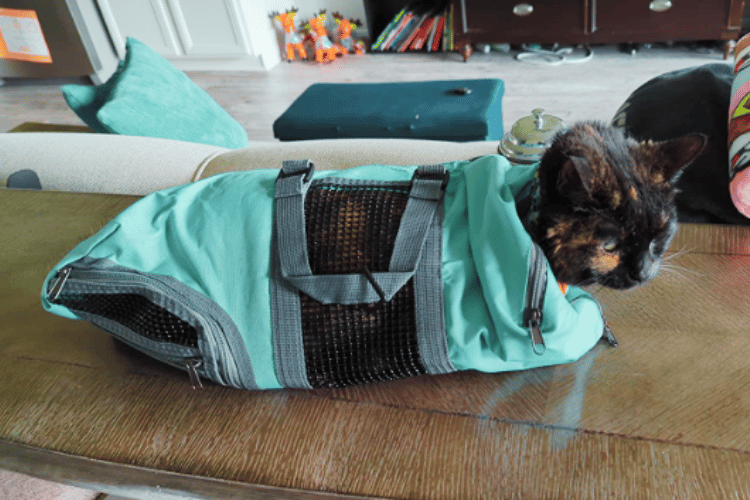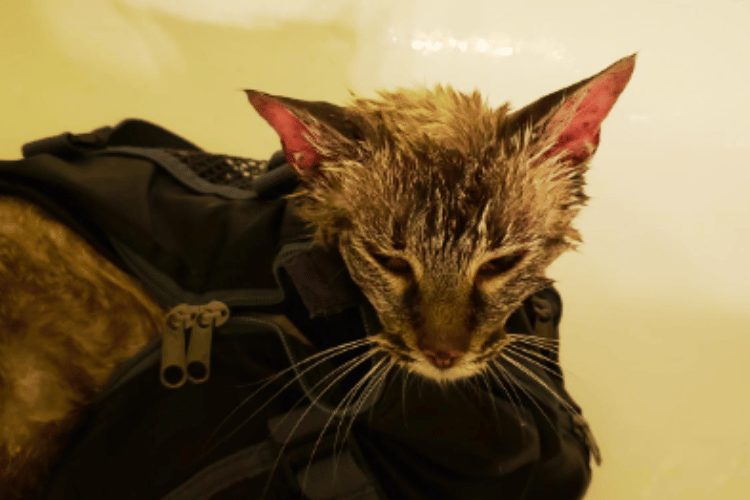Bathing a cat who has more in common with a wild tiger than a cuddly kitten can be akin to defusing a bomb with a fur coat. But fear not, brave soul, for this guide will arm you with the knowledge and tools to turn the tide in the bathtub battle.
Key Takeaways:
- Preparation is Key: Have all your supplies ready and a plan in place before you even think about getting your cat wet.
- Safety First: Protect yourself and your feline friend by keeping their nails trimmed and using protective gear if necessary.
- Patience and Positivity: Use treats and a calm demeanor to create a more positive experience for your cat.

The Calm Before the Storm
Before you even consider turning on the tap, make sure you have everything you need within arm's reach. This includes cat shampoo from your local pet supply store, several towels, a plastic cup for rinsing, and, most importantly, a game plan. Remember, an indoor cat that hates water won't suddenly start loving it, so be prepared for some resistance.
Suit Up for Success
Think of this as your superhero moment. Arm yourself with long sleeves to protect from scratches, and consider wearing gloves. Ensure your cat's nails are trimmed to minimize damage to both your skin and their own in case they try to make a break for it.
The Art of Distraction
Now, let's talk strategy. Many cats are food-motivated, so having a trail of treats leading to the bathtub might just be the Trojan horse you need. Once they're in the bathroom, continue to use treats to create a positive association, even if it's just for a few inches closer to the dreaded bath.
Water Works
When it comes to the water, think Goldilocks: not too hot, not too cold, but just right. Lukewarm water is your best bet. Fill the sink or bathtub with just enough water to get the job done – a few inches should suffice. Remember, most cats enjoy water about as much as they enjoy a flea bath, so keep it minimal.

The Feline Manicure: Trimming Those Claws Before the Splash
Before you even think about introducing your cat to the aquatic wonderland that is your bathroom, let's talk about those miniature scythes they call nails. Trimming your cat's nails is not just a courtesy to your skin; it's a strategic move in the cat bath game. Imagine trying to bathe a tiny Wolverine; that's what skipping this step is like. So, find a good pair of clippers at pet stores, bribe your cat gently with their favorite treat, and snip-snip away to a more peaceful bath time. Remember, it's about making the cat's bath not feel like a scene from a horror movie.
Now, don't go thinking you can just hack away at those talons willy-nilly. You need to be as gentle as a ninja disarming a trap. Hold your cat gently, press their paw to reveal the nails, and trim with care to avoid the quick – that's the pink part that's basically a no-go zone. If you do nick it, there will be blood, and your cat will be plotting revenge for weeks. Keep some styptic powder on hand to stop any bleeding, and remember, this is about trust. Break it, and you might just find your toothbrush mysteriously submerged in the toilet tomorrow.
The Great Escape: Preventing a Houdini Act in the Tub
When it comes to giving your feline friend a bath, think of your tub as a mini Alcatraz. It's not uncommon for a cat to turn into a furry Houdini the moment they sense a bath is imminent. To prevent your cat from making a grand escape, and leaving you with a bathroom that looks like a splash zone, make sure you close all possible exits. This includes the bathroom door, windows, and even the toilet lid – because, let's face it, cats are curious creatures.
Before you introduce your cat to the warm water, create a serene environment that even a spa would envy. Play some soothing music to calm those frisky felines, and ensure the tub is a welcoming place with a non-slip mat. Remember, if your cat's paws feel secure, they're less likely to scramble for freedom. And always keep a firm, but gentle grip on those slippery escape artists, especially around the neck and paws, to avoid an unplanned game of tag in your bathroom.

The Zen of Rinse: Mastering the Art of the Cat's Bath
Mastering the Zen of rinsing your cat can be the difference between a peaceful bath and a feline rebellion. Start by acquainting your cat with the concept of running water. Let them investigate the tub when it's dry, and gradually introduce them to the sound and feel of water. When it's time to bathe your cat, use a pitcher or a gentle shower attachment to pour water over their fur. Avoid the face, ears, and especially the eyes – cats aren't fans of waterlogged whiskers or soapy stares.
As you navigate through the soapy waters of your cat's bath, remember that less is more. Use just enough warm water to get the job done, and a medicated shampoo if fleas are the uninvited guests in your cat's fur. Work up a lather gently with your fingers, avoiding the cat's face and eyes, and always moving in the direction of the fur to prevent tangles. Think of it as a spa treatment – one where the customer has barbed tongues and a tail, and isn't afraid to use them!
The Drying Debate: Towel vs. Blow Dryer Showdown
After the epic battle of bathing your cat, you're faced with a new challenge: getting them dry. Now, you could go for the towel tactic, which is essentially a game of wrap the cat and hope for the best. It's like trying to swaddle a baby that has the agility of a ninja and the mood of a thundercloud. Wrap your cat in a warm towel and gently rub the moisture from their fur. It's a classic move, akin to a warm hug – if hugs involved a lot of wriggling and the occasional hiss.

But wait, there's another contender in the ring – the blow dryer. This can go one of two ways: your cat either sits there like a show cat, basking in the warm breeze, or they transform into a puffed-up, spitting ball of fury. If you choose the path of the blow dryer, keep it on a low setting and maintain a good distance. It's like trying to defuse a bomb that can go off with too much heat or noise. And remember, never point it directly at your cat's face, especially their eyes or ears. If all goes well, your cat will emerge as a fluffy, dry, and only slightly disgruntled puffball.
The Lather, Rinse, Repeat Routine
Using a cat-specific shampoo, gently work up a lather in your cat's fur. Be careful to avoid sensitive areas like the cat's eyes, ears, and face. A plastic cup or a gentle spray nozzle can help you rinse off all the soap without causing a tidal wave of panic.
Towel Tactics
Once the bath is over, wrap your feline companion in a dry towel faster than a magician's trick. Rubbing gently will help remove excess water, but avoid the temptation to use hair dryers as many cats are terrified of the noise. Instead, let them shake off the water and dry naturally in a warm, draft-free room.

Brushing Up
Regular brushing can significantly reduce the need for full-on cat baths. By removing excess hair and distributing natural oils, you're keeping your cat's coat clean and reducing the potential for mats and tangles.
When to Call in the Professionals
Sometimes, it's best to leave the bathing to the pros. If your cat is particularly aggressive or you're not comfortable with the process, a professional groomer or your vet can provide a safe and stress-free bathing experience.
Summary
Bathing an aggressive cat is no easy feat, but with the right preparation, tools, and attitude, it can be done. Remember to keep the water temperature comfortable, use cat-specific shampoo, and always prioritize the safety and comfort of your kitty. With patience, treats, and a gentle touch, you and your cat can survive the bath time battle.

FAQ Section
Q: How often should I bathe my aggressive cat? A: Most cats, especially indoor cats, rarely need baths due to their self-cleaning habits. However, if your cat gets into something dirty or has a skin condition that requires it, consult your vet for advice on bathing frequency.
Q: Can I use human shampoo on my cat? A: No, you should always use a shampoo formulated for cats. Human shampoo can be harsh on a cat's skin and coat, potentially causing irritation or allergic reactions.
Q: What should I do if my cat absolutely refuses to be bathed? A: If your cat is extremely aggressive or stressed by baths, it's best to seek the help of a professional groomer or your vet. They are trained to handle such situations and can ensure your cat's safety and well-being.
Thank you for visiting LegitLists we hope this helps you make a legitimate choice!






